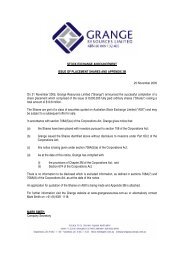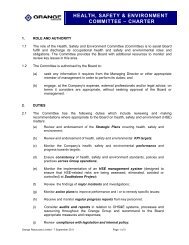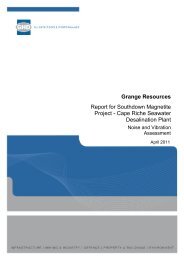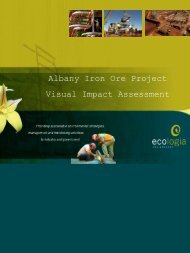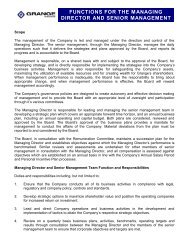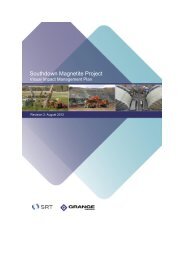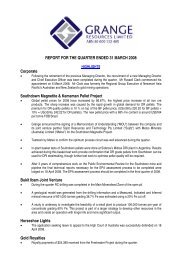Appendix A - Flora and Fauna Survey - Grange Resources
Appendix A - Flora and Fauna Survey - Grange Resources
Appendix A - Flora and Fauna Survey - Grange Resources
Create successful ePaper yourself
Turn your PDF publications into a flip-book with our unique Google optimized e-Paper software.
� The ‘Priority 3’ ecological community – Swamp Yate (Eucalyptus occidentalis) woodl<strong>and</strong>s in<br />
seasonally inundated clay basins (South Coast).<br />
3.2.2 Environmentally Sensitive Areas<br />
The DEC’s online Native Vegetation Viewer was searched to determine the location of any<br />
Environmentally Sensitive Areas (ESAs) within the vicinity of the Study Area, as declared by a Notice<br />
under Section 51B of the EP Act.<br />
There are no ESAs within or adjacent to the Study Area.<br />
3.2.3 South Coast coastal macro-coridor linkage<br />
The South Coast Coastal Macro-Corridor Project was a culmination of local, state <strong>and</strong> international<br />
developments in l<strong>and</strong>scape <strong>and</strong> bioregional-scale nature conservation to help address the threats to<br />
biodiversity through habitat fragmentation. The South Coast Macro-corridor is a network of native<br />
vegetation that extends 700 km from Israelite Bay, east of Esperance <strong>and</strong> westwards through Albany<br />
along Western Australia’s southern coastline, with inl<strong>and</strong> linkages along major river systems to protected<br />
areas <strong>and</strong> other uncleared bushl<strong>and</strong>. High nature conservation values in the area arise from the<br />
existence of a number of large, intact protected areas such as the Stirling Range <strong>and</strong> Fitzgerald River<br />
National Parks. The area is within the South West botanical Province, a biodiversity hotspot of<br />
international significance <strong>and</strong> includes centres of floristic endemism, areas of high floristic diversity <strong>and</strong><br />
important refuges for threatened fauna species. The Macro-corridor project aims to maintain l<strong>and</strong>scapescale<br />
biodiversity <strong>and</strong> meet the needs of the community.<br />
The proposed desalination plant site <strong>and</strong> approximately 7.5kms of the pipeline alignment is located along<br />
the edge of a recognised weak point in this regional corridor. The weak point is between the northern <strong>and</strong><br />
southern sections of Reserve 31240 at the western end of Cape Riche Road; at the narrowest point this<br />
gap is approximately 2 km wide. Most of the l<strong>and</strong> within this area has been cleared for agricultural<br />
purposes. There are some sections of discontinuous vegetation that provide a vegetated linkage,<br />
including a creek line <strong>and</strong> part of Reserve 14943. The proposed site for the Desalination plant is located<br />
centrally within this gap on cleared l<strong>and</strong> <strong>and</strong> the proposed alignment for the pipe line lies adjacent to<br />
Cape Riche road (Wilkins et al., 2006).<br />
3.2.4 Conservation Significant Species<br />
Species of significant flora <strong>and</strong> fauna are protected under both State <strong>and</strong> Commonwealth Acts. Any<br />
activities that are deemed to have a significant impact on species that are recognised by the EPBC Act<br />
<strong>and</strong> the State Wildlife Conservation Act 1950 (WC Act) can trigger referral to DSEWPaC <strong>and</strong>/or the EPA.<br />
The WC Act uses a set of Schedules but also classifies species using some of the IUCN categories. The<br />
EPBC Act protects migratory species that are listed under International Agreements <strong>and</strong> also protects<br />
marine species on Commonwealth l<strong>and</strong>s <strong>and</strong> waters.<br />
In Western Australia, the DEC also produces a supplementary list of Priority flora <strong>and</strong> fauna, these being<br />
species that are not considered Threatened under the WC Act but for which the Department feels there<br />
is a cause for concern. These species have no special legislatory protection, but their presence would<br />
normally be considered. Such taxa need further survey <strong>and</strong> evaluation of conservation status before<br />
consideration can be given to declaration as threatened fauna. Relevant Federal <strong>and</strong> State conservation<br />
codes are provided in further detail in <strong>Appendix</strong> B.<br />
8



